

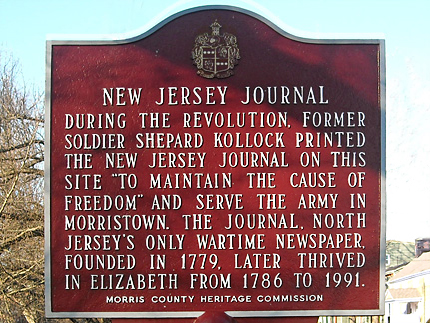
New Jersey Journal Site
55 Main St.
Map / Directions to Chatham Revolutionary War Sites
The New Jersey Journal was the only newspaper published in North Jersey during the Revolutionary War; it reported on the events of the war from a pro-American point of view. (New Jersey's other newspaper during the war, the New Jersey Gazette, was published in Central Jersey, in Burlington and then Trenton.)
The first edition of the New Jersey Journal was published on February 16, 1779, by Shepard Kollock, who had previously served in the Morris County Militia and the Continental Army before setting up his printing press in Chatham. He published the newspaper throughout the rest of the war in several different buildings in Chatham which were located near this sign. [1]
In June 1780, British troops invaded New Jersey, making it as far as Springfield, less than five miles from here, resulting in the Battle of Springfield. To protect his printing press, Shepard Kollock evacuated Chatham with his equipment, causing the New Jersey Journal to miss publication for a week. [2]
In 1786, Kollock began publishing the New Jersey Journal in Elizabeth. Its name was later changed to the Elizabeth Daily Journal, and it remained in publication until January 3, 1992. [3]

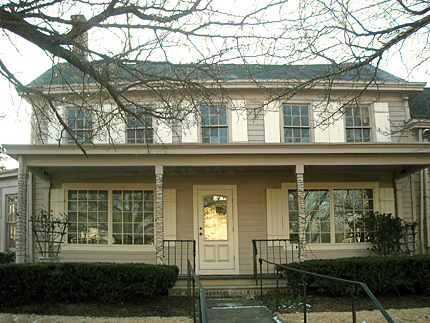
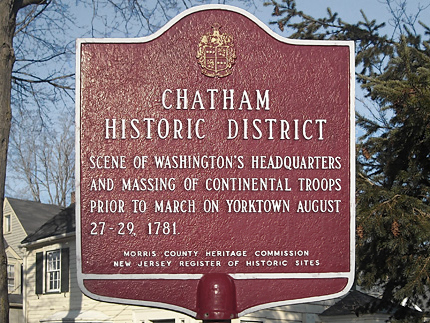
Jacob Morrell House
Now the Scalini Fedeli restaurant.
63 Main St.
Map / Directions to Chatham Revolutionary War Sites
Chatham Historic District Sign
Located about 100 yards west of the Jacob Morrell House, on
Main St., near Roosevelt Ave
The Continental Army in Chatham - August 1781 [4]
Although there were no battles fought in Chatham during the Revolutionary War, there was a great deal of military activity in and around the town. [5] Chatham played its most important military role in the Revolutionary War in August 1781, when between two and three thousand Continental (American) troops stopped to encamp here during a long march down the east coast towards Yorktown, Virginia. Also marching along a different route were French troops, who had recently arrived in America to fight as allies alongside the Continental Army.
General George Washington arrived on the scene on August 27. He is believed to have made his headquarters at the home of Jacob Morrell, which is now used as the Scalini Fedeli restaurant. [6]
During the encampment in August 1781, Washington knew that he was heading towards Yorktown, Virginia, where circumstances were arising that would allow the Americans, with the help of the French, to deliver a crushing and decisive blow to the British. However, he worked hard to conceal his plans from the British forces in New York City under the command of General Henry Clinton. His intention was to have the British believe that the Americans (and their French allies) would be making an attack on the British troops in New York City. Chatham would have appeared to be a likely place to launch an attack on New York City, which is located about twenty miles to the east. The longer he could fool the British as to his real intentions, the harder it would be for them to plan for Washington's move towards Yorktown.
Washington's efforts to keep his plans secret were so intense that the Continental soldiers at Chatham did not know what their next move would be. While Washington did share his intentions with some of his senior officers, his letters to them from this period are filled with mentions of the need for secrecy and for deceiving the British as to his intentions. [7]
The residents of Chatham were also unaware of what the army's plans were; many of the townspeople believed the army would be remaining at Chatham for an extended time. This helped ensure that information about the Yorktown destination would not be discovered by British spies.
Crucial to Washington's plans to deceive the British was to make it look as if the army were planning an extended encampment in Chatham, from which they could launch an attack on New York City. To help create the appearance of an extended encampment, Washington ordered the construction of large ovens, housed within a 65-foot long shed. The ovens were operated by some French troops, and guarded by American soldiers. [8] These ovens were capable of baking enough bread to feed the thousands of soldiers encamped at Chatham, as well as the thousands of French troops who were encamped about six miles away at Whippany. This gave the appearance of the ovens having been created for a sustained stay in Chatham.
Washington's efforts to deceive the British were completely successful. When the Continental Army left Chatham before sunrise on August 29, to head for Yorktown Virginia, it took more than a day before the British in New York were even aware that the Continental troops had left Chatham.
The Continental Army, along with their French allies, arrived at Yorktown on September 28 and surrounded the town, which was occupied by thousands of British troops under the command of General Cornwallis. Fighting lasted for several weeks, ending in Cornwallis's surrender of the British forces at Yorktown on October 19, which helped to ensure the American victory in the war. While smaller-scale fighting occurred for the next two years, Yorktown was the last major battle of the Revolutionary War. [9]

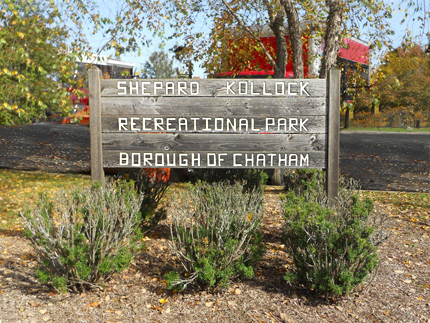
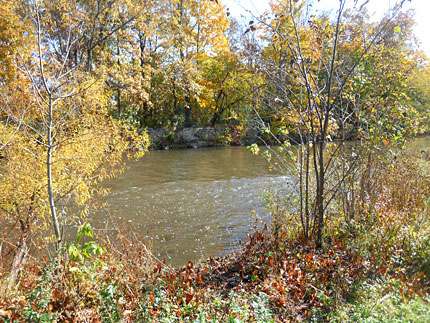
Shepard Kollock Park
16 Henderson Rd.
Map / Directions to Chatham Revolutionary War Sites
This park is named for Shepard Kollock who published the New Jersey Journal in Chatham during the Revolutionary War. (See the New Jersey Journal Site entry above on this page.)
The park is located along the Passaic River. It is sometimes described as the site of where the ovens were built during the August 1781 encampment, but it is possible that those ovens may have been constructed at another location nearby. Whether or not the ovens were constructed here, some of the thousands of Continental troops in the area at the time undoubtedly walked over and camped on the fields that now make up the park.

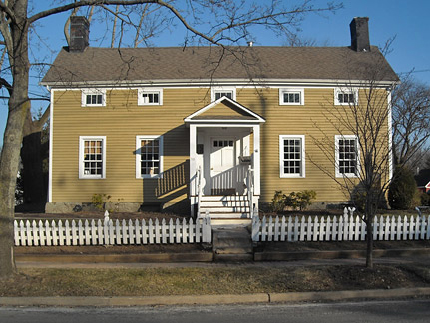
William Day House
70 Main St.
Map / Directions to Chatham Revolutionary War Sites
This house is now the office of Marquis Wealth Advisors.
William Day served in the Morris County Militia during the Revolutionary War, beginning as a Private and rising to the rank of Captain. [10]
The house was built circa 1780. It is now used as offices and has no historic markers to note its history. [11]

1. ^ Donald Wallace White, A Village At War - Chatham, New Jersey and the Revolutionary War (Rutherford, Madison, and Teaneck NJ: Fairleigh Dickinson University Press, 1979) Pages 120-131
2. ^ "The printing-office having been removed in the late alarm, was the reason this paper was not published last week," The New-Jersey Journal, Vol. II., Numb. LXXII., July 5, 1780, reprinted in:
William Nelson, Editor, Archives of the State of New Jersey, Second Series, Vol. IV Extracts From American Newspapers Relating to New Jersey, Nov. 1, 1779 - Sept. 30, 1780 (Trenton: State Gazette Publishing Co., 1914) Page 477
Available to be read at the Internet Archive here3. ^ "NJ's Oldest Newspaper Turns Off Presses," UPI, January 3, 1992
4. ^ In addition to the sources listed in source notes 5-8, the following book was consulted in the writing of this entry:
Donald Wallace White, A Village At War - Chatham, New Jersey and the Revolutionary War (Rutherford, Madison, and Teaneck NJ: Fairleigh Dickinson University Press, 1979) Pages 179-1805. ^ Some of the other military events affecting Chatham are listed below. These events are described in detail on the pages linked in the text, along with accompanying source notes.
• In December 1776, General Charles Lee passed through Chatham and stopped here, days before his capture at Widow White's Tavern in Basking Ridge.
• In January 1777, the Continental (American) Army began the first of two large and lengthy winter encampments in Morristown, located just ten miles away.
• The Continental Army returned to Morristown in December 1779; they were still there the following June when some Continental Army troops came through Chatham from Morristown, en route to the Battle of Springfield.
• In January 1781, a small body of Continental troops who were stationed in Chatham were affected by the Pompton Mutiny.
~ The entry about General Charles Lee's capture on the Basking Ridge page does not specifically mention his presence in Chatham several days before, so the following additional sources are listed below for Lee's presence in Chatham on December 8, 1776.
The two letters listed below were both written by Lee to Washington on December 8, 1776. The first was sent from Morristown, in which Lee mentions his intention to go to Chatham. The second, written later that day, is marked as having been written from Chatham.
• “To George Washington from Major General Charles Lee, 8 December 1776,” Founders Online, National Archives, last modified July 12, 2016, http://founders.archives.gov/documents/Washington/03-07-02-0215. [Original source: The Papers of George Washington, Revolutionary War Series, vol. 7, 21 October 1776–5 January 1777, ed. Philander D. Chase. Charlottesville: University Press of Virginia, 1997, p. 276.]
• “To George Washington from Major General Charles Lee, 8 December 1776,” Founders Online, National Archives, last modified July 12, 2016, http://founders.archives.gov/documents/Washington/03-07-02-0216. [Original source: The Papers of George Washington, Revolutionary War Series, vol. 7, 21 October 1776–5 January 1777, ed. Philander D. Chase. Charlottesville: University Press of Virginia, 1997, p. 277.]
6. ^ That Washington was in Chatham from August 27-29 is firmly established by the letters he wrote during those days.
• Washington's letters from August 27-28 are marked as being sent from "Chatham" or "Headquarters Chatham"
Many of these letters are available to be read at the Founders Online / National Archives website here• Letters written by Washington on August 29 are marked as being sent either from Chatham, Brunswick, or Trenton, showing that Washington began the day in Chatham and then traveled to Trenton by way of New Brunswick that day.
Available to be read at the Founders Online / National Archives website here
While the documentation for Washington's presence in Chatham during this period is conclusive, the documentation for Washington specifically making his headquarters in the Morrell House seems to be based entirely on local tradition. None of Washington's letters written from Chatham specify which house he was in.
A number of secondary sources state that the Jacob Morrell House was likely Washington's headquarters at Chatham, including:
• Charles A. Philhower, "Chatham," in A History of Morris County, New Jersey: Embracing Upwards of Two Centuries, 1710-1913, Volume I (New York and Chicago: Lewis Historical Publishing Co., 1914)
Available to be read at the Internet Archive here
• Ambrose E. Vanderpoel, History of Chatham, New Jersey (New York: Charles Francis Press, 1921) Pages 381-383
Available to be read at the Internet Archive here• Donald Wallace White, A Village At War - Chatham, New Jersey and the Revolutionary War (Rutherford, Madison, and Teaneck NJ: Fairleigh Dickinson University Press, 1979) Pages 179-180
7. ^ Two examples from Washington's letters appear below:
• “From George Washington to Samuel Miles, 27 August 1781,” Founders Online, National Archives, last modified July 12, 2016, http://founders.archives.gov/documents/Washington/99-01-02-06801. [This is an Early Access document from The Papers of George Washington. It is not an authoritative final version.]
▸ In this letter, Washington wrote:
"I have delayed having these preparations made until this Moment, because I wished to deceive the Enemy with regard to our real object as long as possible— our movements have been calculated for that purpose and I am still anxious the deception should be kept up a few days longer, until our intentions are announced by the Army's filing off towards the Delaware."• From George Washington to William Colfax, 28 August 1781,” Founders Online, National Archives, last modified July 12, 2016, http://founders.archives.gov/documents/Washington/99-01-02-06808. [This is an Early Access document from The Papers of George Washington. It is not an authoritative final version.]
▸ In this letter, Washington wrote:
"Your Rout, & every thing relative to the inclosed order, is to be kept secret till the nature of the movement discloses itself."8. ^ The building of the ovens is noted in many contemporary sources, including:
• “From George Washington to Elias Dayton, 19 August 1781,” Founders Online, National Archives, last modified July 12, 2016, http://founders.archives.gov/documents/Washington/99-01-02-06727. [This is an Early Access document from The Papers of George Washington. It is not an authoritative final version.]
• “From George Washington to Noah Webster, 31 July 1788,” Founders Online, National Archives, last modified July 12, 2016, http://founders.archives.gov/documents/Washington/04-06-02-0376. [Original source: The Papers of George Washington, Confederation Series, vol. 6, 1 January 1788 – 23 September 1788, ed. W. W. Abbot. Charlottesville: University Press of Virginia, 1997, pp. 413–416.]
▸ This letter, written seven years after the event, contains Washington's recollections of having made "a deceptive provision of Ovens."• Joseph Plumb Martin, Edited by George F. Scheer, Private Yankee Doodle (Eastern National: 2012 Edition) Page 222
• James Thacher, A Military Journal During the American Revolutionary War, From 1775 to 1783 (Boston: Richardson and Lord, 1823) Page 322
Available to be read at the Internet Archive here• New-York Mercury, August 27, 1781, reprinted in:
Frank Moore, Diary of the American Revolution: from Newspapers and Original Documents, Volume II (New York: Charles Scribner, Grand Street / London: Sampson Low, Son & Company, 1860) Page 466
Available to be read at the Internet Archive here9. ^ Other historic sites in New Jersey related to the march to the Battle of Yorktown can be found in Liberty Corner, Pequannock, Montville, Whippany, Montgomery Township, and Princeton.
For information about visiting the Yorktown Battlefield, see the Yorktown Battlefield section of the National Historic Park website.
10. ^ Donald Wallace White, A Village At War - Chatham, New Jersey and the Revolutionary War (Rutherford, Madison, and Teaneck NJ: Fairleigh Dickinson University Press, 1979) Page 68
11. ^"A Saturday Stroll Down East Main Street" brochure, (The Chatham Historical Society, March 25, 1972) Pages 7-8
▸ Identifies this house as having been that of William Day